Personal Privacy Concerns: Facial Recognition Technology Report
VerifiedAdded on 2022/10/06
|8
|1633
|21
Report
AI Summary
This report examines the escalating concerns surrounding personal privacy in the context of facial recognition technology. It delves into the technology's applications, highlighting the privacy risks associated with its widespread use, including data collection, surveillance, and potential misuse of facial data by both governmental and private entities. The report focuses on the Aotearoa New Zealand context, recommending regulatory policies for the government to safeguard citizens' privacy rights. It explores the role of individuals in protecting their privacy by offering practical strategies to minimize exposure to facial recognition systems. The report emphasizes the need for a balanced approach that fosters technological advancement while upholding fundamental privacy principles, ensuring that facial recognition is used responsibly and ethically.
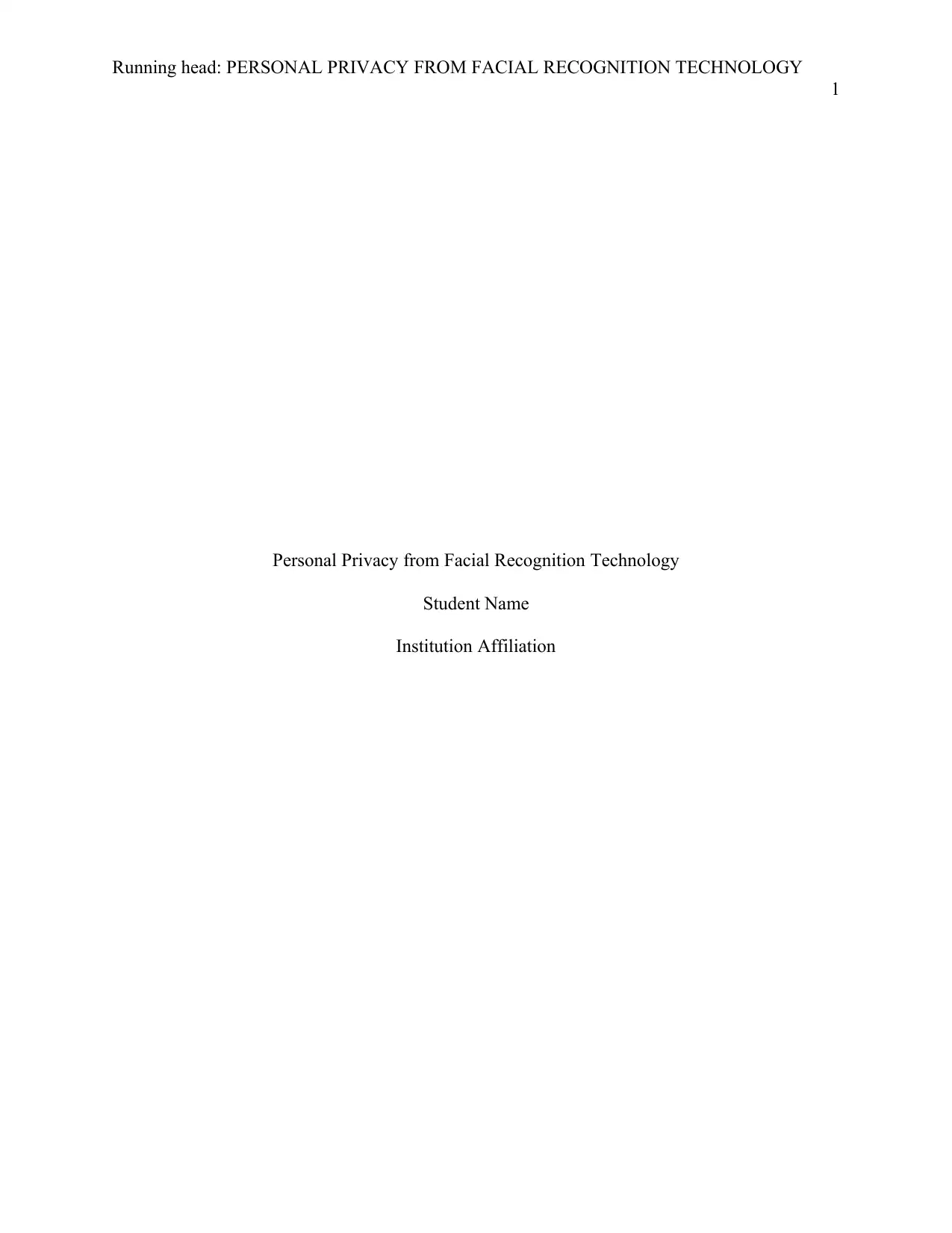
Running head: PERSONAL PRIVACY FROM FACIAL RECOGNITION TECHNOLOGY
1
Personal Privacy from Facial Recognition Technology
Student Name
Institution Affiliation
1
Personal Privacy from Facial Recognition Technology
Student Name
Institution Affiliation
Paraphrase This Document
Need a fresh take? Get an instant paraphrase of this document with our AI Paraphraser
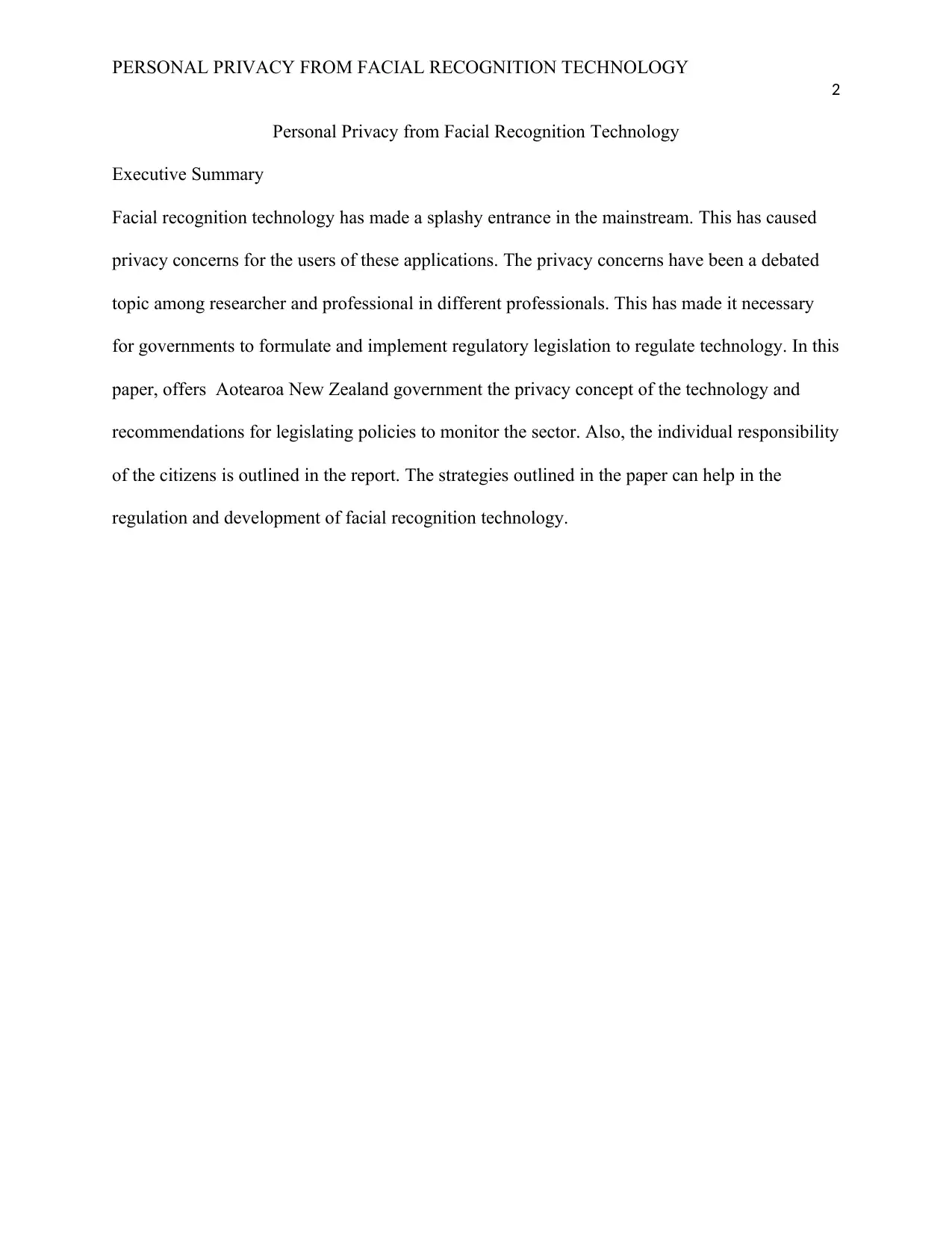
PERSONAL PRIVACY FROM FACIAL RECOGNITION TECHNOLOGY
2
Personal Privacy from Facial Recognition Technology
Executive Summary
Facial recognition technology has made a splashy entrance in the mainstream. This has caused
privacy concerns for the users of these applications. The privacy concerns have been a debated
topic among researcher and professional in different professionals. This has made it necessary
for governments to formulate and implement regulatory legislation to regulate technology. In this
paper, offers Aotearoa New Zealand government the privacy concept of the technology and
recommendations for legislating policies to monitor the sector. Also, the individual responsibility
of the citizens is outlined in the report. The strategies outlined in the paper can help in the
regulation and development of facial recognition technology.
2
Personal Privacy from Facial Recognition Technology
Executive Summary
Facial recognition technology has made a splashy entrance in the mainstream. This has caused
privacy concerns for the users of these applications. The privacy concerns have been a debated
topic among researcher and professional in different professionals. This has made it necessary
for governments to formulate and implement regulatory legislation to regulate technology. In this
paper, offers Aotearoa New Zealand government the privacy concept of the technology and
recommendations for legislating policies to monitor the sector. Also, the individual responsibility
of the citizens is outlined in the report. The strategies outlined in the paper can help in the
regulation and development of facial recognition technology.
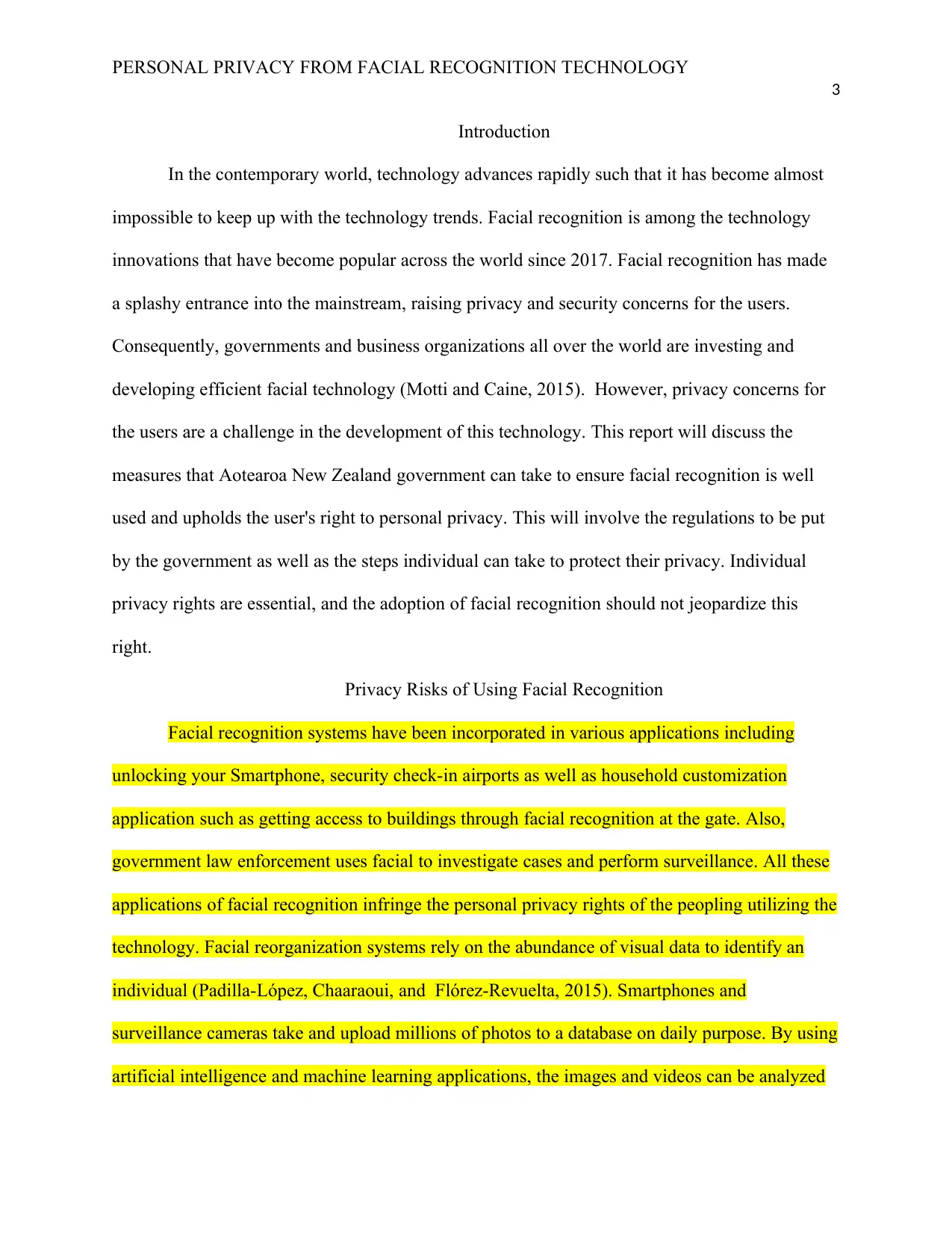
PERSONAL PRIVACY FROM FACIAL RECOGNITION TECHNOLOGY
3
Introduction
In the contemporary world, technology advances rapidly such that it has become almost
impossible to keep up with the technology trends. Facial recognition is among the technology
innovations that have become popular across the world since 2017. Facial recognition has made
a splashy entrance into the mainstream, raising privacy and security concerns for the users.
Consequently, governments and business organizations all over the world are investing and
developing efficient facial technology (Motti and Caine, 2015). However, privacy concerns for
the users are a challenge in the development of this technology. This report will discuss the
measures that Aotearoa New Zealand government can take to ensure facial recognition is well
used and upholds the user's right to personal privacy. This will involve the regulations to be put
by the government as well as the steps individual can take to protect their privacy. Individual
privacy rights are essential, and the adoption of facial recognition should not jeopardize this
right.
Privacy Risks of Using Facial Recognition
Facial recognition systems have been incorporated in various applications including
unlocking your Smartphone, security check-in airports as well as household customization
application such as getting access to buildings through facial recognition at the gate. Also,
government law enforcement uses facial to investigate cases and perform surveillance. All these
applications of facial recognition infringe the personal privacy rights of the peopling utilizing the
technology. Facial reorganization systems rely on the abundance of visual data to identify an
individual (Padilla-López, Chaaraoui, and Flórez-Revuelta, 2015). Smartphones and
surveillance cameras take and upload millions of photos to a database on daily purpose. By using
artificial intelligence and machine learning applications, the images and videos can be analyzed
3
Introduction
In the contemporary world, technology advances rapidly such that it has become almost
impossible to keep up with the technology trends. Facial recognition is among the technology
innovations that have become popular across the world since 2017. Facial recognition has made
a splashy entrance into the mainstream, raising privacy and security concerns for the users.
Consequently, governments and business organizations all over the world are investing and
developing efficient facial technology (Motti and Caine, 2015). However, privacy concerns for
the users are a challenge in the development of this technology. This report will discuss the
measures that Aotearoa New Zealand government can take to ensure facial recognition is well
used and upholds the user's right to personal privacy. This will involve the regulations to be put
by the government as well as the steps individual can take to protect their privacy. Individual
privacy rights are essential, and the adoption of facial recognition should not jeopardize this
right.
Privacy Risks of Using Facial Recognition
Facial recognition systems have been incorporated in various applications including
unlocking your Smartphone, security check-in airports as well as household customization
application such as getting access to buildings through facial recognition at the gate. Also,
government law enforcement uses facial to investigate cases and perform surveillance. All these
applications of facial recognition infringe the personal privacy rights of the peopling utilizing the
technology. Facial reorganization systems rely on the abundance of visual data to identify an
individual (Padilla-López, Chaaraoui, and Flórez-Revuelta, 2015). Smartphones and
surveillance cameras take and upload millions of photos to a database on daily purpose. By using
artificial intelligence and machine learning applications, the images and videos can be analyzed
⊘ This is a preview!⊘
Do you want full access?
Subscribe today to unlock all pages.

Trusted by 1+ million students worldwide
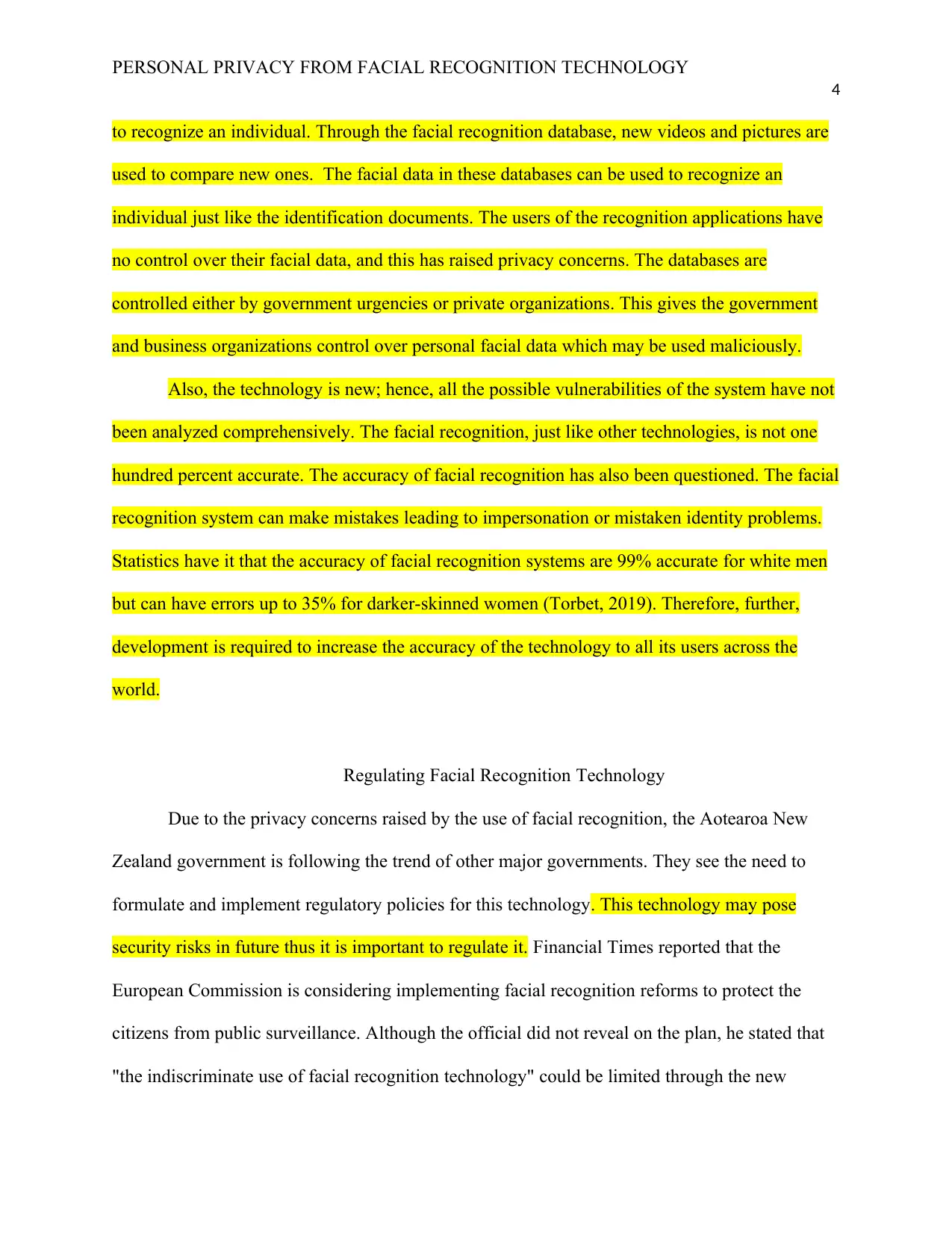
PERSONAL PRIVACY FROM FACIAL RECOGNITION TECHNOLOGY
4
to recognize an individual. Through the facial recognition database, new videos and pictures are
used to compare new ones. The facial data in these databases can be used to recognize an
individual just like the identification documents. The users of the recognition applications have
no control over their facial data, and this has raised privacy concerns. The databases are
controlled either by government urgencies or private organizations. This gives the government
and business organizations control over personal facial data which may be used maliciously.
Also, the technology is new; hence, all the possible vulnerabilities of the system have not
been analyzed comprehensively. The facial recognition, just like other technologies, is not one
hundred percent accurate. The accuracy of facial recognition has also been questioned. The facial
recognition system can make mistakes leading to impersonation or mistaken identity problems.
Statistics have it that the accuracy of facial recognition systems are 99% accurate for white men
but can have errors up to 35% for darker-skinned women (Torbet, 2019). Therefore, further,
development is required to increase the accuracy of the technology to all its users across the
world.
Regulating Facial Recognition Technology
Due to the privacy concerns raised by the use of facial recognition, the Aotearoa New
Zealand government is following the trend of other major governments. They see the need to
formulate and implement regulatory policies for this technology. This technology may pose
security risks in future thus it is important to regulate it. Financial Times reported that the
European Commission is considering implementing facial recognition reforms to protect the
citizens from public surveillance. Although the official did not reveal on the plan, he stated that
"the indiscriminate use of facial recognition technology" could be limited through the new
4
to recognize an individual. Through the facial recognition database, new videos and pictures are
used to compare new ones. The facial data in these databases can be used to recognize an
individual just like the identification documents. The users of the recognition applications have
no control over their facial data, and this has raised privacy concerns. The databases are
controlled either by government urgencies or private organizations. This gives the government
and business organizations control over personal facial data which may be used maliciously.
Also, the technology is new; hence, all the possible vulnerabilities of the system have not
been analyzed comprehensively. The facial recognition, just like other technologies, is not one
hundred percent accurate. The accuracy of facial recognition has also been questioned. The facial
recognition system can make mistakes leading to impersonation or mistaken identity problems.
Statistics have it that the accuracy of facial recognition systems are 99% accurate for white men
but can have errors up to 35% for darker-skinned women (Torbet, 2019). Therefore, further,
development is required to increase the accuracy of the technology to all its users across the
world.
Regulating Facial Recognition Technology
Due to the privacy concerns raised by the use of facial recognition, the Aotearoa New
Zealand government is following the trend of other major governments. They see the need to
formulate and implement regulatory policies for this technology. This technology may pose
security risks in future thus it is important to regulate it. Financial Times reported that the
European Commission is considering implementing facial recognition reforms to protect the
citizens from public surveillance. Although the official did not reveal on the plan, he stated that
"the indiscriminate use of facial recognition technology" could be limited through the new
Paraphrase This Document
Need a fresh take? Get an instant paraphrase of this document with our AI Paraphraser
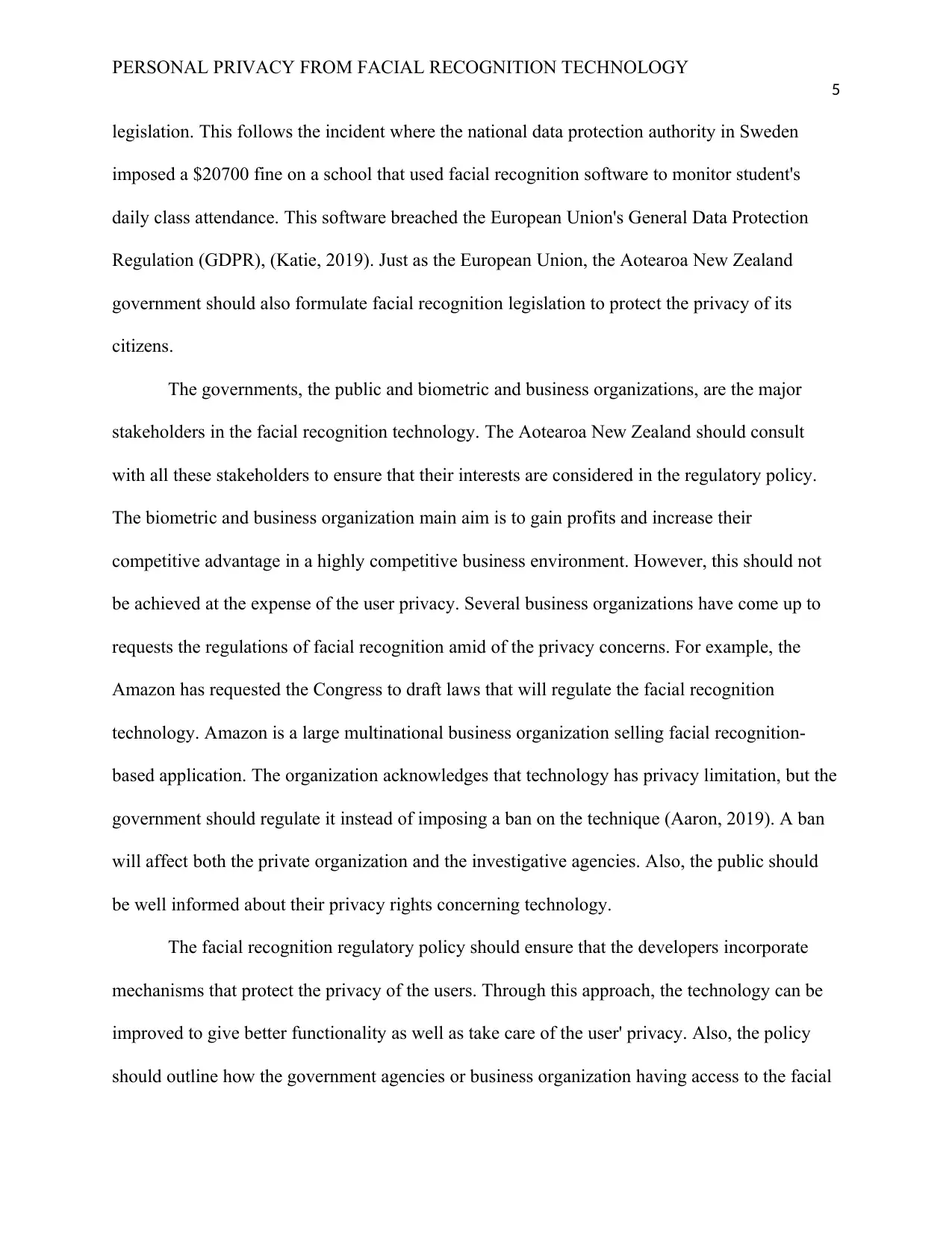
PERSONAL PRIVACY FROM FACIAL RECOGNITION TECHNOLOGY
5
legislation. This follows the incident where the national data protection authority in Sweden
imposed a $20700 fine on a school that used facial recognition software to monitor student's
daily class attendance. This software breached the European Union's General Data Protection
Regulation (GDPR), (Katie, 2019). Just as the European Union, the Aotearoa New Zealand
government should also formulate facial recognition legislation to protect the privacy of its
citizens.
The governments, the public and biometric and business organizations, are the major
stakeholders in the facial recognition technology. The Aotearoa New Zealand should consult
with all these stakeholders to ensure that their interests are considered in the regulatory policy.
The biometric and business organization main aim is to gain profits and increase their
competitive advantage in a highly competitive business environment. However, this should not
be achieved at the expense of the user privacy. Several business organizations have come up to
requests the regulations of facial recognition amid of the privacy concerns. For example, the
Amazon has requested the Congress to draft laws that will regulate the facial recognition
technology. Amazon is a large multinational business organization selling facial recognition-
based application. The organization acknowledges that technology has privacy limitation, but the
government should regulate it instead of imposing a ban on the technique (Aaron, 2019). A ban
will affect both the private organization and the investigative agencies. Also, the public should
be well informed about their privacy rights concerning technology.
The facial recognition regulatory policy should ensure that the developers incorporate
mechanisms that protect the privacy of the users. Through this approach, the technology can be
improved to give better functionality as well as take care of the user' privacy. Also, the policy
should outline how the government agencies or business organization having access to the facial
5
legislation. This follows the incident where the national data protection authority in Sweden
imposed a $20700 fine on a school that used facial recognition software to monitor student's
daily class attendance. This software breached the European Union's General Data Protection
Regulation (GDPR), (Katie, 2019). Just as the European Union, the Aotearoa New Zealand
government should also formulate facial recognition legislation to protect the privacy of its
citizens.
The governments, the public and biometric and business organizations, are the major
stakeholders in the facial recognition technology. The Aotearoa New Zealand should consult
with all these stakeholders to ensure that their interests are considered in the regulatory policy.
The biometric and business organization main aim is to gain profits and increase their
competitive advantage in a highly competitive business environment. However, this should not
be achieved at the expense of the user privacy. Several business organizations have come up to
requests the regulations of facial recognition amid of the privacy concerns. For example, the
Amazon has requested the Congress to draft laws that will regulate the facial recognition
technology. Amazon is a large multinational business organization selling facial recognition-
based application. The organization acknowledges that technology has privacy limitation, but the
government should regulate it instead of imposing a ban on the technique (Aaron, 2019). A ban
will affect both the private organization and the investigative agencies. Also, the public should
be well informed about their privacy rights concerning technology.
The facial recognition regulatory policy should ensure that the developers incorporate
mechanisms that protect the privacy of the users. Through this approach, the technology can be
improved to give better functionality as well as take care of the user' privacy. Also, the policy
should outline how the government agencies or business organization having access to the facial
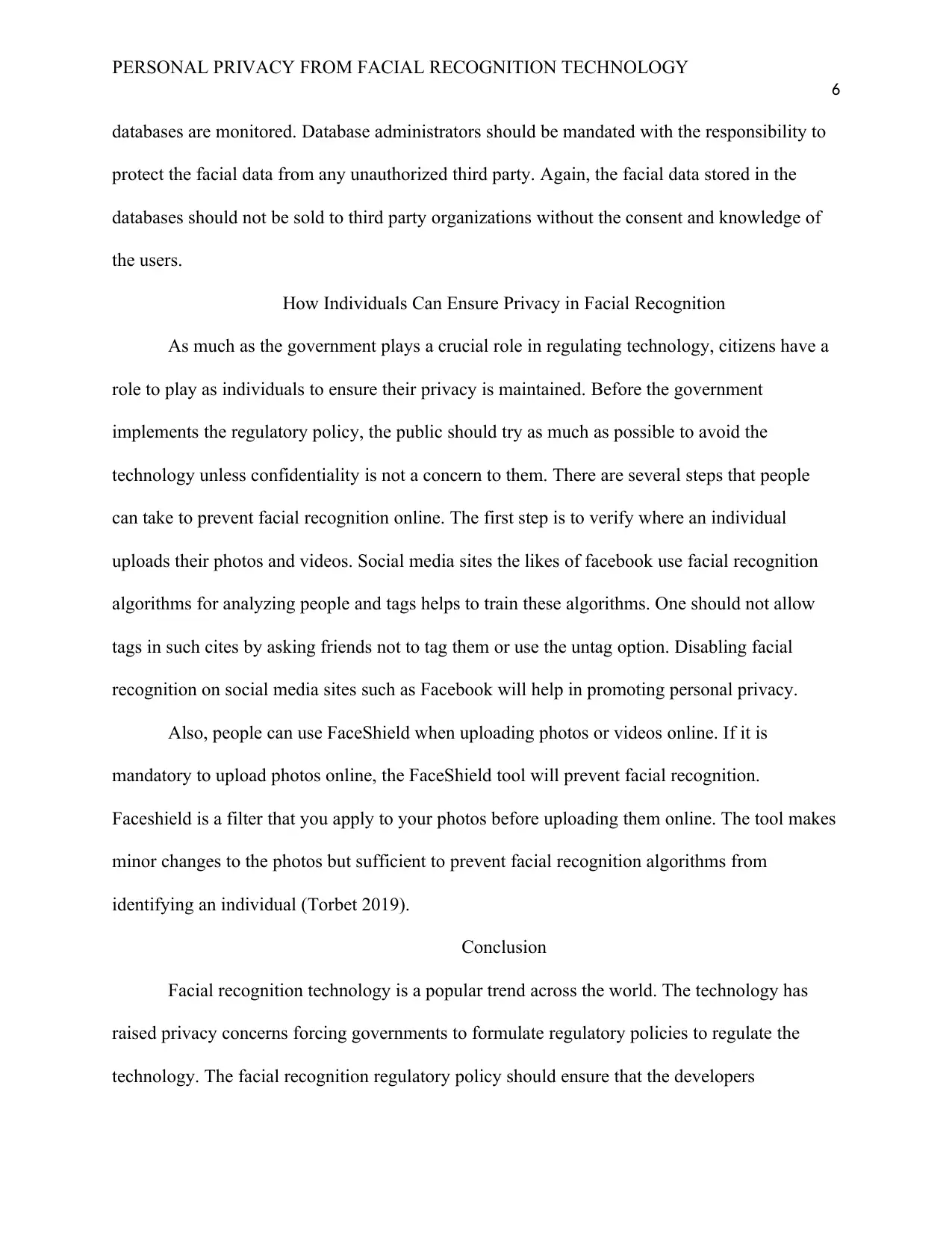
PERSONAL PRIVACY FROM FACIAL RECOGNITION TECHNOLOGY
6
databases are monitored. Database administrators should be mandated with the responsibility to
protect the facial data from any unauthorized third party. Again, the facial data stored in the
databases should not be sold to third party organizations without the consent and knowledge of
the users.
How Individuals Can Ensure Privacy in Facial Recognition
As much as the government plays a crucial role in regulating technology, citizens have a
role to play as individuals to ensure their privacy is maintained. Before the government
implements the regulatory policy, the public should try as much as possible to avoid the
technology unless confidentiality is not a concern to them. There are several steps that people
can take to prevent facial recognition online. The first step is to verify where an individual
uploads their photos and videos. Social media sites the likes of facebook use facial recognition
algorithms for analyzing people and tags helps to train these algorithms. One should not allow
tags in such cites by asking friends not to tag them or use the untag option. Disabling facial
recognition on social media sites such as Facebook will help in promoting personal privacy.
Also, people can use FaceShield when uploading photos or videos online. If it is
mandatory to upload photos online, the FaceShield tool will prevent facial recognition.
Faceshield is a filter that you apply to your photos before uploading them online. The tool makes
minor changes to the photos but sufficient to prevent facial recognition algorithms from
identifying an individual (Torbet 2019).
Conclusion
Facial recognition technology is a popular trend across the world. The technology has
raised privacy concerns forcing governments to formulate regulatory policies to regulate the
technology. The facial recognition regulatory policy should ensure that the developers
6
databases are monitored. Database administrators should be mandated with the responsibility to
protect the facial data from any unauthorized third party. Again, the facial data stored in the
databases should not be sold to third party organizations without the consent and knowledge of
the users.
How Individuals Can Ensure Privacy in Facial Recognition
As much as the government plays a crucial role in regulating technology, citizens have a
role to play as individuals to ensure their privacy is maintained. Before the government
implements the regulatory policy, the public should try as much as possible to avoid the
technology unless confidentiality is not a concern to them. There are several steps that people
can take to prevent facial recognition online. The first step is to verify where an individual
uploads their photos and videos. Social media sites the likes of facebook use facial recognition
algorithms for analyzing people and tags helps to train these algorithms. One should not allow
tags in such cites by asking friends not to tag them or use the untag option. Disabling facial
recognition on social media sites such as Facebook will help in promoting personal privacy.
Also, people can use FaceShield when uploading photos or videos online. If it is
mandatory to upload photos online, the FaceShield tool will prevent facial recognition.
Faceshield is a filter that you apply to your photos before uploading them online. The tool makes
minor changes to the photos but sufficient to prevent facial recognition algorithms from
identifying an individual (Torbet 2019).
Conclusion
Facial recognition technology is a popular trend across the world. The technology has
raised privacy concerns forcing governments to formulate regulatory policies to regulate the
technology. The facial recognition regulatory policy should ensure that the developers
⊘ This is a preview!⊘
Do you want full access?
Subscribe today to unlock all pages.

Trusted by 1+ million students worldwide
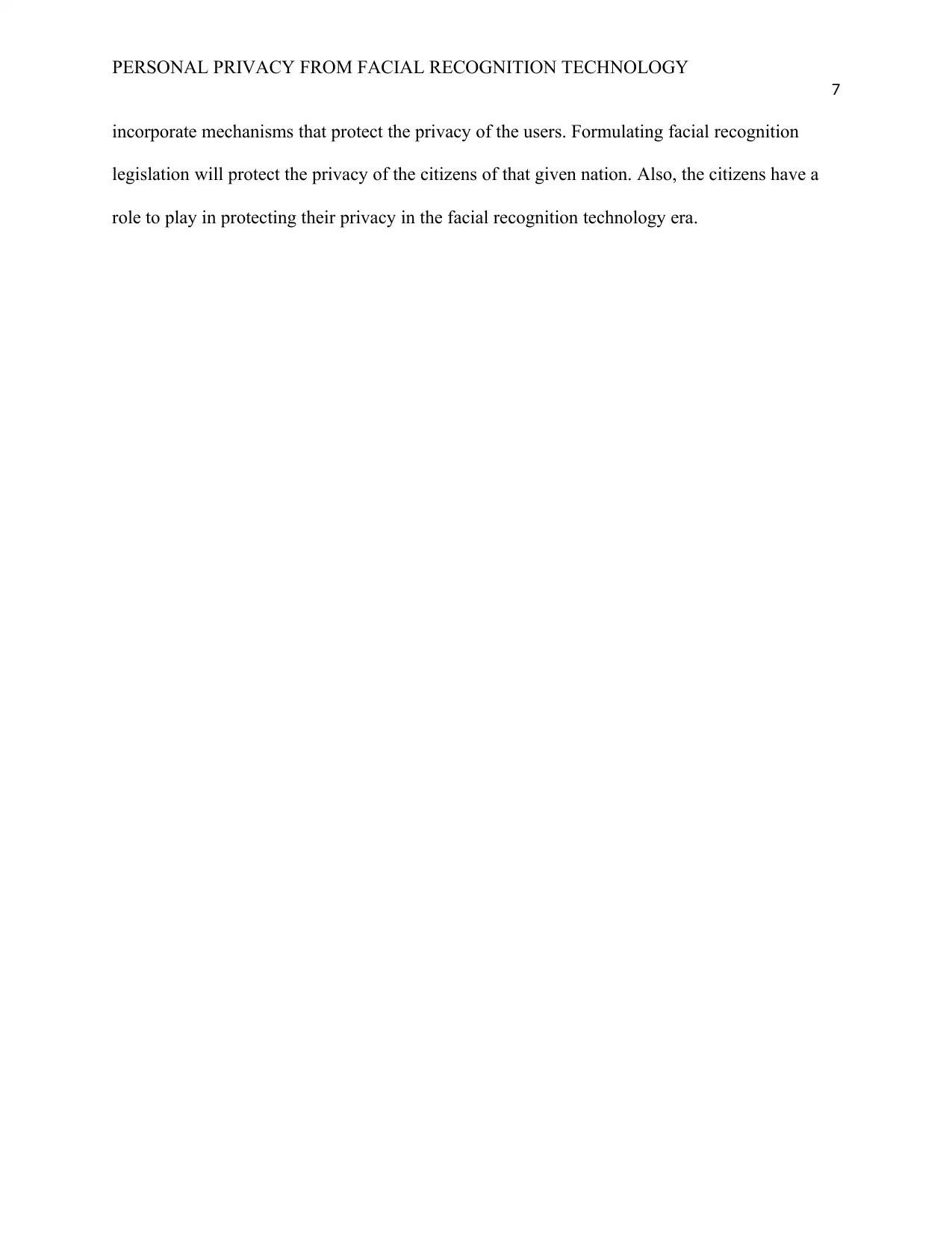
PERSONAL PRIVACY FROM FACIAL RECOGNITION TECHNOLOGY
7
incorporate mechanisms that protect the privacy of the users. Formulating facial recognition
legislation will protect the privacy of the citizens of that given nation. Also, the citizens have a
role to play in protecting their privacy in the facial recognition technology era.
7
incorporate mechanisms that protect the privacy of the users. Formulating facial recognition
legislation will protect the privacy of the citizens of that given nation. Also, the citizens have a
role to play in protecting their privacy in the facial recognition technology era.
Paraphrase This Document
Need a fresh take? Get an instant paraphrase of this document with our AI Paraphraser
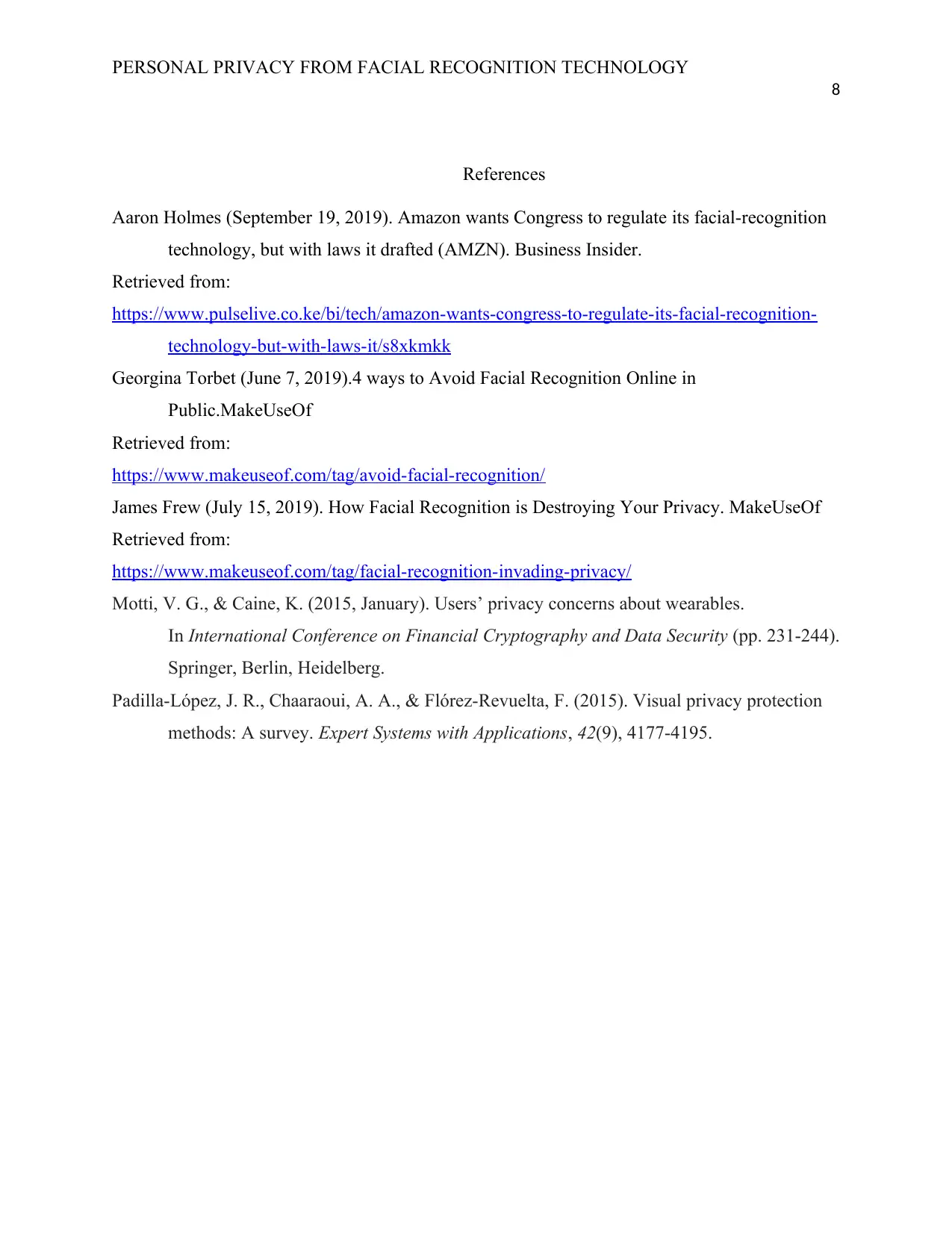
PERSONAL PRIVACY FROM FACIAL RECOGNITION TECHNOLOGY
8
References
Aaron Holmes (September 19, 2019). Amazon wants Congress to regulate its facial-recognition
technology, but with laws it drafted (AMZN). Business Insider.
Retrieved from:
https://www.pulselive.co.ke/bi/tech/amazon-wants-congress-to-regulate-its-facial-recognition-
technology-but-with-laws-it/s8xkmkk
Georgina Torbet (June 7, 2019).4 ways to Avoid Facial Recognition Online in
Public.MakeUseOf
Retrieved from:
https://www.makeuseof.com/tag/avoid-facial-recognition/
James Frew (July 15, 2019). How Facial Recognition is Destroying Your Privacy. MakeUseOf
Retrieved from:
https://www.makeuseof.com/tag/facial-recognition-invading-privacy/
Motti, V. G., & Caine, K. (2015, January). Users’ privacy concerns about wearables.
In International Conference on Financial Cryptography and Data Security (pp. 231-244).
Springer, Berlin, Heidelberg.
Padilla-López, J. R., Chaaraoui, A. A., & Flórez-Revuelta, F. (2015). Visual privacy protection
methods: A survey. Expert Systems with Applications, 42(9), 4177-4195.
, 2019
8
References
Aaron Holmes (September 19, 2019). Amazon wants Congress to regulate its facial-recognition
technology, but with laws it drafted (AMZN). Business Insider.
Retrieved from:
https://www.pulselive.co.ke/bi/tech/amazon-wants-congress-to-regulate-its-facial-recognition-
technology-but-with-laws-it/s8xkmkk
Georgina Torbet (June 7, 2019).4 ways to Avoid Facial Recognition Online in
Public.MakeUseOf
Retrieved from:
https://www.makeuseof.com/tag/avoid-facial-recognition/
James Frew (July 15, 2019). How Facial Recognition is Destroying Your Privacy. MakeUseOf
Retrieved from:
https://www.makeuseof.com/tag/facial-recognition-invading-privacy/
Motti, V. G., & Caine, K. (2015, January). Users’ privacy concerns about wearables.
In International Conference on Financial Cryptography and Data Security (pp. 231-244).
Springer, Berlin, Heidelberg.
Padilla-López, J. R., Chaaraoui, A. A., & Flórez-Revuelta, F. (2015). Visual privacy protection
methods: A survey. Expert Systems with Applications, 42(9), 4177-4195.
, 2019
1 out of 8
Related Documents
Your All-in-One AI-Powered Toolkit for Academic Success.
+13062052269
info@desklib.com
Available 24*7 on WhatsApp / Email
![[object Object]](/_next/static/media/star-bottom.7253800d.svg)
Unlock your academic potential
Copyright © 2020–2025 A2Z Services. All Rights Reserved. Developed and managed by ZUCOL.





